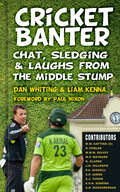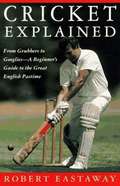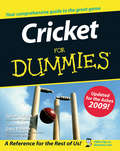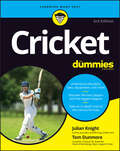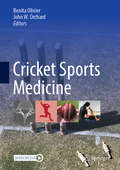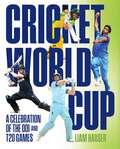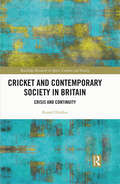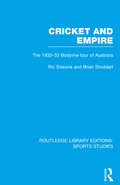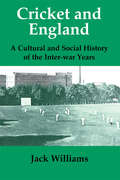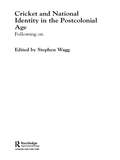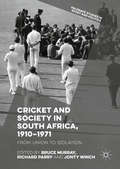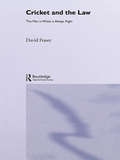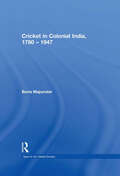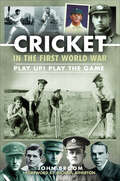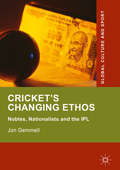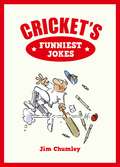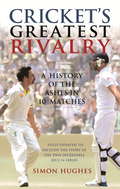- Table View
- List View
Cricket Banter: Chat, Sledging and Laughs from The Middle Stump
by Paul Nixon Dan Whiting Liam KennaCricket Banter is all the rage among the cricketing cognoscenti and the chat, the sledging and the humour behind the game is all covered here, by those boys at The Middle Stump, in conjunction with Factor 50. Here we cover most aspects of cricket, as we speak with some of the finest, funniest, larger than life characters from the sport over the last thirty years, along with a selection of hilarious stories about the game. It’s a highly amusing book; read it and you’ll see why most cricketers, whether from club, county or international level, as well as the sport’s most prominent journalists are all talking about those cheeky chaps from The Middle Stump, and their alternative take on the game of cricket.
Cricket Explained
by Robert EastawayCricket Explained offers the sports enthusiast a user-friendly introduction to baseball's British cousin, a game that shares with America's national pastime the common ancestor "rounders". This is the definitive beginner's guide to the game of cricket, written by a world authority on the sport, the co-inventor of the Coopers & Lybrand World Cricket Ratings System. Cricket Explained takes the reader from the game's fundamentals -- basic rules, terminology, equipment -- to the finer points of strategy, individual playing styles, and cricket lore. The book includes a combined glossary/index for easy reference and is illustrated throughout with the lighthearted drawings of British cartoonist Mark Stevens. So even if you don't know "short leg" from "silly mid off" or a bowler from a batsman, you'll come away from Cricket Explained with an understanding for this truly international sport which, like baseball, is loved both for its elegant simplicity and its vexing complexity. Among the topics covered in Cricket Explained's concise, user-friendly entries are: Cricket's history; Making sense of the action on the field; Batsmen and the batting order; Fielders and fielding positions; Fielding and batting tactics; Scoring and statistics; Bowling strategy; How many players are required; How runs are scored, outs are made, and a game is won; Umpires and the rules; Bowlers and their individual styles; Different types of cricket played throughout the world, and more.
Cricket Explained: From Grubbers to Googlies—A Beginner's Guide to the Great English Pastime
by Rob EastawayCricket Explained offers the sports enthusiast a user-friendly introduction to baseball's British cousin, a game that shares with America's national pastime the common ancestor "rounders."This is the definitive beginner's guide to the game of cricket, written by Robert Eastaway, a world authority on the sport, and co-inventor of the Coopers & Lybrand World Cricket Ratings System. Cricket Explained takes the reader from the game's fundamental --basic rules, terminology, equipment --to the finer points of strategy, individual playing styles, and cricket lore.The book includes a combined glossary/index for easy reference and is illustrated throughout with the lighthearted drawings of British cartoonist Mark Stevens. So even if you don't know "short leg" from "silly mid off" or a bowler from a batsman, you'll come away from Cricket Explained with an understanding for this truly international sport which, like baseball, is loved both for its elegant simplicity and its vexing complexity.Among the topics covered in Cricket Explained's concise, user-friendly entries are:-- Cricket's history-- Making sense of the action on the field-- Batsmen and the batting order-- Fielders and fielding positions-- Fielding and batting tactics-- Scoring and statistics-- Bowling strategy-- How many players are required-- How runs are scored, outs are made, and a game is won-- Umpires and the rules-- Bowlers and their individual styles-- Different types of cricket played throughout the world
Cricket For Dummies
by Julian Knight Gary Palmer Steve BullWhether you're a weekend cricketer or aspiring armchair expert, Cricket For Dummies helps you make sense of this fascinating sport. Not just a jargon busting guide to cricket's laws, techniques and tactics, it also contains advice on kitting yourself out and provides lessons on playing the game and improving your batting, bowling and fielding skills. For the budding fan, there's a guide to the greatest players, the memorable matches, and a tour through the cricketing scene - both domestic and international - giving you the knowledge you need to fully appreciate this special game.This book has been updated for the Ashes 2009, featuring revised information on new players, the Indian premier league, Stanford 20:20 and the latest coverage of past and future competitions.Julian Knight is a BBC journalist, writer, and cricket enthusiast. He is a former youth coach and captain, and has been a club cricketer for over 20 years.Consultant Editor Gary Palmer played first class cricket for ten years with Somerset before becoming a professional coach.
Cricket For Dummies
by Julian KnightA complete guide to cricket for players and fans alike Whether you're a budding player or aspiring armchair expert, Cricket For Dummies helps you get to grips with this fascinating sport. Completely revised and updated for the first back-to-back Ashes series in 38 years, this hands-on guide gives you clear explanations of the cricket's laws, step-by-step explanations of techniques and tactics, and exciting coverage of the tournaments, global rivalries, and great players. Fully revised and updated to chronicle the rise of twenty20 cricket and the IPL, the implementation of DRS, and the changing face of the game Covers cricket basics—the pitch, the laws, the equipment and more Provides an in-depth look at cricket formats Offers a guide to building cricket skills—bowling, batting, and fielding Includes coverage of the best players and the biggest tournaments throughout the world Complete with Top Ten Lists of the greatest cricketers, the most memorable cricket matches, and the biggest controversies, Cricket For Dummies is your one-stop resource on this popular sport.
Cricket For Dummies
by Julian Knight Tom DunmoreCurious about the game of cricket? Start here! Cricket For Dummies, Third Edition will help you understand the basics of cricket, the internationally popular sport that has leagues around the globe. With this guide, you can enjoy watching matches, and even set up a casual game with friends. The book includes clear explanations of the rules, step-by-step guides to strategy and tactics, and info on all the most popular tournaments around the globe. Learn about the cricket greats of today and yesterday, plus get updates on the latest developments, including Major League Cricket and the Cricket World Cup. This new edition of Cricket For Dummies is a fascinating and thorough introduction to the sport, in the classic, easy-to-understand Dummies style. Learn the laws of cricket so you can watch games and follow league play Set up a game of cricket and play with your friends Get the latest updates in the cricket world, including upcoming must-watch tournaments Figure out the strategies and techniques that make cricket so interestingCricket For Dummies, Third Edition is a valuable resource for new fans who want to understand the game of cricket.
Cricket Sports Medicine
by Benita Olivier John W. OrchardCricket Sports Medicine amalgamates insights from leading experts in various healthcare fields into a cohesive, evidence-based guide that reflects the collaborative spirit essential for optimal cricket care. The book takes a comprehensive, holistic approach to injury prevention, management, and rehabilitation in cricket. It covers epidemiological data on cricket injuries, biomechanical analysis of key skills like bowling, fielding and wicketkeeping, equipment considerations, pre-participation screening methods, and important conditioning aspects like warm-up and load management strategies. It delves into return-to-play protocols and nutritional guidance for performance and recovery. A dedicated section explains the assessment and management of lumbar stress fractures, with other common cricket injuries and illnesses covered as well. The text encompasses the latest research, case studies, and practical applications compiled by experts worldwide, empowering healthcare providers with the much-needed tools to deliver superior care to cricketers at every level. This book caters to the needs of healthcare providers navigating the nuances of cricket-related injuries. It fosters a deeper understanding of the sport's physical demands and the holistic care required for athletes. Cricket Sports Medicine recognises the range of healthcare professionals involved in cricketers' well-being and serves as an essential resource for doctors, physiotherapists, podiatrists, nutritionists, chiropractors, psychologists, exercise physiologists and all healthcare providers working with cricketers across diverse competitive and recreational levels.
Cricket World Cup
by Liam HauserA wonderful time capsule of cricket history, this is a fully illustrated history of the Cricket World Cup since 1975 by acclaimed sports writer Liam Hauser.Celebrating the sport's peak competition since 1975, acclaimed sports writer Liam Hauser, author of The Immortals of Australian Cricket, examines each tournament across both One Day International and Twenty20 formats, including extensive coverage of World Cup semi-finals and finals, and detailing memorable moments and key performances such as hat-tricks, five-wicket hauls, and sparkling centuries. This book is a wonderful time capsule of cricket history. It illustrates how the game developed a new peak competition in limited-over formats over the past five decades– from 60- and 50-over one-day internationals in the 1970s to popular Twenty20 tournaments in the 2000s. Supported by essential stats and wonderful photos of the era, Cricket World Cup is an indispensable resource for cricket enthusiasts and will proudly occupy a place on every sporting tragic's bookshelf.
Cricket and Contemporary Society in Britain: Crisis and Continuity (Routledge Research in Sport, Culture and Society)
by Russell HoldenThis book investigates the declining status of cricket within contemporary British society after the high-water mark of England’s Ashes victory in 2005. It considers the deep roots of the game within British national life as well as its ever-changing nature, and reflects upon the current significance and relevance of a sport that many still perceive as deeply traditional and conservative in outlook. Adopting a socio-political approach, the book offers new perspectives on both the contemporary realities of modern cricket and the social, cultural and political condition of modern Britain. Rather than focusing on personality and the detail of match history, the book looks at how the sport has coped with wider societal changes, such as those in Afro-Caribbean and South Asian communities, and how this has demanded adaptation by cricket’s governing authorities. The book also considers the international context in which the game continues to develop and how the initiative with new formats such as Twenty20 has been lost to other cricketing nations, and it offers insight into the continued expansion and recent professionalization of the women’s game, hinting at ways in which cricket as a whole could recapture the public’s imagination. Cricket and Contemporary Society in Britain is an invaluable resource for those studying the sociology of sport, sport history, cultural studies, the politics of sport, cultural identity, sport management and sport development. It is also a fascinating read for anybody with an interest in cricket or in the value of sport in an era of rapid socio-economic, political and cultural change.
Cricket and Empire: The 1932-33 Bodyline Tour of Australia (Routledge Library Editions: Sports Studies)
by Ric Sissons Brian StoddartA great depression, worsening Anglo-Australian relations, the declining British Empire and the challenge from an Australia striving to find a national identity are the context which explain bodyline and its repercussions. Bodyline was a watershed in the history of cricket and politics were publicly seen as part of sport. This book offers a radical reappraisal of bodyline which challenges the official interpretations of the events, and places them in a unique social and political context. .
Cricket and England: A Cultural and Social History of Cricket in England between the Wars (Sport in the Global Society #No. 8)
by Mr Jack WilliamsLooking at the inter-war period, this work explores the relationship between cricket and English social and cultural values.
Cricket and National Identity in the Postcolonial Age: Following On
by Stephen WaggBringing together leading international writers on cricket and society, this important new book places cricket in the postcolonial life of the major Test-playing countries. Exploring the culture, politics, governance and economics of cricket in the twenty-first century, this book dispels the age-old idea of a gentle game played on England's village greens. This is an original political and historical study of the game's development in a range of countries and covers: * cricket in the new Commonwealth: Sri Lanka, Pakistan, the Caribbean and India* the cricket cultures of Australia, New Zealand and post-apartheid South Africa * cricket in England since the 1950s. This new book is ideal for students of sport, politics, history and postcolonialism as it provides stimulating and comprehensive discussions of the major issues including race, migration, gobalization, neoliberal economics, the media, religion and sectarianism.
Cricket and Society in South Africa, 1910–1971: From Union To Isolation (Palgrave Studies in Sport and Politics)
by Richard Parry Bruce Murray Jonty WinchThis book explores how cricket in South Africa was shaped by society and society by cricket. It demonstrates the centrality of cricket in the evolving relationship between culture, sport and politics starting with South Africa as the beating heart of the imperial project and ending with the country as an international pariah. The contributors explore the tensions between fragmentation and unity, on and off the pitch, in the context of the racist ideology of empire, its ‘arrested development’ and the reliance of South Africa on a racially based exploitative labour system. This edited collection uncovers the hidden history of cricket, society, and empire in defining a multiplicity of South African identities, and recognises the achievements of forgotten players and their impact.
Cricket and the Law: The Man in White is Always Right (Routledge Studies in Law, Society and Popular Culture)
by David FraserCricket, law and the meaning of life ... In a readable, informed and absorbing discussion of cricket’s defining controversies – bodyline, chucking, ball-tampering, sledging, walking and the use of technology, among many others – David Fraser explores the ambiguities of law and social order in cricket. Cricket and the Law charts the interrelationship between cricket and legal theory – between the law of the game and the law of our lives – and demonstrates how cricket’s cultural conventions can escape the confines of the game to carry far broader social meanings. This engaging study will be enjoyed by lawyers, students of culture and cricket lovers everywhere.
Cricket for Schools (J. T. Hankinson on Sport)
by J. T. HankinsonOriginally published in 1946, this was primarily a cricket book for schools and contained much that was new at the time. It was written by a schoolmaster, produced in a school, and a unique feature was that the action photographs are of boys who were at that time in the school team. The author had been coaching school cricket of all grades, Junior Games, House Games, and 1st XI teams for about 20 years, and was at the time of publication in charge of the cricket at Canford School, which, for a relatively small school, had recently produced some very good sides and players. In this book his methods are analysed in a style felt likely to commend itself to readers of all ages.There are 97 action photographs to illustrate the author’s teaching.While this book was primarily for schools, the instructional detail and the attractiveness of the photographs would also have appealed to more mature cricketers and the book was strongly recommended to all who are interested in the game. Today it can be enjoyed in its historical context.
Cricket in Colonial India, 1780–1947 (Sport In The Global Society Ser.)
by Boria MajumdarThis is an exacting social history of Indian cricket between 1780 and 1947. It considers cricket as a derivative sport, creatively adapted to suit modern Indian socio-cultural needs, fulfil political imperatives and satisfy economic aspirations. Majumdar argues that cricket was a means to cross class barriers and had a healthy following even outside the aristocracy and upper middle classes well over a century ago. Indeed, in some ways, the democratization of the sport anticipated the democratization of the Indian polity itself. Boria Majumdar reveals the appropriation, assimilation and subversion of cricketing ideals in colonial and post-colonial India for nationalist ends. He exposes a sport rooted in the contingencies of the colonial and post-colonial context of nineteenth- and twentieth-century India. Cricket, to put it simply, is much more than a ‘game’ for Indians. This study describes how the genealogy of their intense engagement with cricket stretches back over a century. It is concerned not only with the game but also with the end of cricket as a mere sport, with Indian cricket’s commercial revolution in the 1930s, with ideals and idealism and their relative unimportance, with the decline of morality for reasons of realpolitik, and with the denunciation, once and for all, of the view that sport and politics do not mix. This book was previously published as a special issue of the International Journal of the History of Sport
Cricket in the First World War: Play up! Play the Game
by John BroomAs Europe descended into war over the summer of 1914, cricket in England continued as it had for the preceding few decades. Counties continued with their championship programme, clubs in the North and Midlands maintained their league and cup rivalries whilst less competitive clubs elsewhere enjoyed friendly matches. However, voices were soon raised in criticism of this ‘business as usual’ approach – most notably that of cricket’s Grand Old Man, W.G. Grace. Names became absent from first-class and club scorecards as players left for military service and by the end of the year it was clear that 1915’s cricket season would be very different. And so it would continue for four summers. Rolls of honour lengthened as did the grim lists of cricket’s dead and maimed. Some club cricket did continue in wartime Britain, often amidst bitter disputes as to its appropriateness. Charity matches were organised to align the game with the national war effort. As the British Empire rallied behind the mother country, so cricket around the world became restricted and players from far and wide joined the sad ranks of sacrifice. Cricket emerged into the post-war world initially unsure of itself but the efforts that had been made to sustain the game’s infrastructure during the conflict ensured that it would experience a second golden age between the wars.
Cricket in the Second World War: The Grim Test
by John BroomAs the civilised world fought for its very survival, Sir Home Gordon, writing in The Cricketer in September 1939, stated that ‘England has now started the grim Test Match with Germany’, the objective of which was to ‘win the Ashes of civilisation’. Despite the interruption of first-class and Test cricket in England, the game continued to be played and watched by hundreds of thousands of people engaged in military and civilian service. In workplaces, cricket clubs, and military establishments, as well as on the famous grounds of the country, players of all abilities kept the sporting flag flying to sustain morale. Matches raised vast sums for war charities whilst in the north and midlands, competitive League cricket continued, with many Test and county players being employed as weekend professionals by the clubs. Further afield the game continued in all the Test-playing nations and in further-flung outposts around the world. Troops stationed in Europe, Africa and the Far East seized on any opportunity to play cricket, often in the most unusual of circumstances. Luxurious sporting clubs in Egypt hosted matches that pitted English service teams against their Commonwealth counterparts. Luminaries such as Wally Hammond and Lindsay Hassett were cheered on by their uniformed countrymen. Inevitably there was a sombre side to cricket’s wartime account. From renowned Test stars such as Hedley Verity to the keen but modest club player, many cricketers paid the ultimate price for Allied victory. The Victory Tests of 1945 were played against a backdrop of relief and sorrow. Nevertheless, cricket would emerge intact into the post-war world in broadly the same format as 1939. The game had sustained its soul and played its part in the sad but necessary victory of the Grim Test.
Cricket in the Second World War: The Grim Test
by John BroomAs the civilised world fought for its very survival, Sir Home Gordon, writing in The Cricketer in September 1939, stated that ‘England has now started the grim Test Match with Germany’, the objective of which was to ‘win the Ashes of civilisation’. Despite the interruption of first-class and Test cricket in England, the game continued to be played and watched by hundreds of thousands of people engaged in military and civilian service. In workplaces, cricket clubs, and military establishments, as well as on the famous grounds of the country, players of all abilities kept the sporting flag flying to sustain morale. Matches raised vast sums for war charities whilst in the north and midlands, competitive League cricket continued, with many Test and county players being employed as weekend professionals by the clubs. Further afield the game continued in all the Test-playing nations and in further-flung outposts around the world. Troops stationed in Europe, Africa and the Far East seized on any opportunity to play cricket, often in the most unusual of circumstances. Luxurious sporting clubs in Egypt hosted matches that pitted English service teams against their Commonwealth counterparts. Luminaries such as Wally Hammond and Lindsay Hassett were cheered on by their uniformed countrymen. Inevitably there was a sombre side to cricket’s wartime account. From renowned Test stars such as Hedley Verity to the keen but modest club player, many cricketers paid the ultimate price for Allied victory. The Victory Tests of 1945 were played against a backdrop of relief and sorrow. Nevertheless, cricket would emerge intact into the post-war world in broadly the same format as 1939. The game had sustained its soul and played its part in the sad but necessary victory of the Grim Test.
Cricket's Bearded Wonder
by Bill FrindallBill Frindall, or Bearders, is well known to cricket fans from Test Match Special.Bearders took over the scoring for Test Match Special in June 1966, at the First Test against West Indies at Old Trafford. He was nicknamed the Bearded Wonder by Brian Johnston because of his encyclopedic knowledge of cricket scores and statistics.In this wonderful recording, Bearders recalls the voices and characters of Test Match Special in his own unique style. He looks back on the funniest moments in the commentary box, and remembers the great characters he has worked with.Cricket's Bearded Wonder is a fitting tribute to a much-loved cricketing legend.(P)2009 Hodder & Stoughton Ltd
Cricket's Changing Ethos (Global Culture and Sport Series)
by Jon GemmellThis book examines historically how cricket was codified out of its variant folk-forms and then marketed with certain lessons sought to reinforce the values of a declining landed interest. It goes on to show how such values were then adapted as part of the imperial experiment and were eventually rejected and replaced with an ethos that better reflected the interests of new dominant elites. The work examines the impact of globalisation and marketization on cricket and analyses the shift from an English dominance, on a sport that is ever-increasingly being shaped by Asian forces. The book’s distinctiveness lies in trying to decode the spirit of the game, outlining a set of actual characteristics rather than a vague sense of values. An historical analysis shows how imperialism, nationalism, commercialism and globalisation have shaped and adapted these characteristics. As such it will be of interest to students and scholars of sport sociology, post-colonialism, globalisation as well as those with an interest in the game of cricket and sport more generally.
Cricket's Funniest Jokes
by Jim ChumleyPatient: Doctor, I think I’m a cricket ball! Doctor: Don’t worry, it’ll be over soon. Crammed full of hilarious cricketing jokes from players and pundits alike, Cricket’s Funniest Jokes will bowl over any fan of the gentleman’s game – guaranteed to raise a laugh when you’re stumped or when rain stops play.
Cricket's Funniest Jokes
by Jim ChumleyPatient: Doctor, I think I’m a cricket ball! Doctor: Don’t worry, it’ll be over soon. Crammed full of hilarious cricketing jokes from players and pundits alike, Cricket’s Funniest Jokes will bowl over any fan of the gentleman’s game – guaranteed to raise a laugh when you’re stumped or when rain stops play.
Cricket's Greatest Rivalry: A History Of The Ashes In 10 Matches
by Simon Hughes'Hughes takes us on a breathless tour through cricket history, the great players, personalities, matches and events. He never slackens pace or dwells on the dry details of the scoreboard.' - The TimesFrom the William Hill Award-Winning author of A Lot of Hard Yakka comes Cricket's Greatest Rivalry: A History of the Ashes in 10 Matches, a fast-paced, distinctive history of the iconic, 135-year-old cricketing rivalry between England and Australia. The new paperback edition is completely revised and updated to include the tumultuous two series of 2013-2014, which saw more more twists and turns in this enthralling contest. No other sport has a fixture like the Ashes. From the early 1880s the rivalry between these two great sporting nations has captured the public imagination and made sporting legends of its stars. Commentator, analyst and award-winning cricket historian Simon Hughes tells the story of the ten seminal series that have become the stuff of sporting folklore. Cricket's Greatest Rivalry places you right at the heart of the action of each pivotal match, explaining the social context of the time, the atmosphere of the crowd and the background and temperaments of the players that battled in both baggy green and blue caps.Simon starts his story at the very birth of the Ashes and tells the tale of the band of Australians that took on the best gentleman and players in the Empire's HQ and beat them on their home turf. That momentous occasion set the tone for some epic contests including:The thrilling 1902 Test at Old Trafford, which was one by a mere three runs.The incredible innings of Hobbs and Sutcliffe in front of a tense and packed Oval in 1926.The legendary 'bodyline' series of Jardine, Larwood, Bradman et al in 1933.The incredible run chase in 1948 that also saw Bradman's last test.England's reprise in the fifth test of 1953 when Lock, Trueman, Bailey and Hutton steered the hosts to a whirlwind victory.The fearsome pace attack from the likes of Lillie and Thompson that transformed the contest in the first Test of 1974 and shaped the Ashes as a tournament for decades to come.Botham's Ashes in 1981 that restored pride in a sports-mad nation.The match up at old Trafford where the magic of one Shane Warne sent shockwaves through the game.And finally the breaking of the Aussie stranglehold in 2005, when Flintoff, Pietersen and Vaughan did the seemingly impossible and re-established the greatest of rivalries.The book also includes complete statistics and records of all the Ashes fixtures and results and much, much more!
Cricket's Greatest Rivalry: A History Of The Ashes In 10 Matches
by Simon Hughes'Hughes takes us on a breathless tour through cricket history, the great players, personalities, matches and events. He never slackens pace or dwells on the dry details of the scoreboard.' - The Times From the William Hill Award-Winning author of A Lot of Hard Yakka comes Cricket's Greatest Rivalry: A History of the Ashes in 10 Matches, a fast-paced, distinctive history of the iconic, 135-year-old cricketing rivalry between England and Australia. The new paperback edition is completely revised and updated to include the tumultuous two series of 2013-2014, which saw more more twists and turns in this enthralling contest. No other sport has a fixture like the Ashes. From the early 1880s the rivalry between these two great sporting nations has captured the public imagination and made sporting legends of its stars. Commentator, analyst and award-winning cricket historian Simon Hughes tells the story of the ten seminal series that have become the stuff of sporting folklore. Cricket's Greatest Rivalry places you right at the heart of the action of each pivotal match, explaining the social context of the time, the atmosphere of the crowd and the background and temperaments of the players that battled in both baggy green and blue caps. Simon starts his story at the very birth of the Ashes and tells the tale of the band of Australians that took on the best gentleman and players in the Empire's HQ and beat them on their home turf. That momentous occasion set the tone for some epic contests including: The thrilling 1902 Test at Old Trafford, which was one by a mere three runs. The incredible innings of Hobbs and Sutcliffe in front of a tense and packed Oval in 1926. The legendary 'bodyline' series of Jardine, Larwood, Bradman et al in 1933. The incredible run chase in 1948 that also saw Bradman's last test. England's reprise in the fifth test of 1953 when Lock, Trueman, Bailey and Hutton steered the hosts to a whirlwind victory. The fearsome pace attack from the likes of Lillie and Thompson that transformed the contest in the first Test of 1974 and shaped the Ashes as a tournament for decades to come. Botham's Ashes in 1981 that restored pride in a sports-mad nation. The match up at old Trafford where the magic of one Shane Warne sent shockwaves through the game. And finally the breaking of the Aussie stranglehold in 2005, when Flintoff, Pietersen and Vaughan did the seemingly impossible and re-established the greatest of rivalries. The book also includes complete statistics and records of all the Ashes fixtures and results and much, much more!
